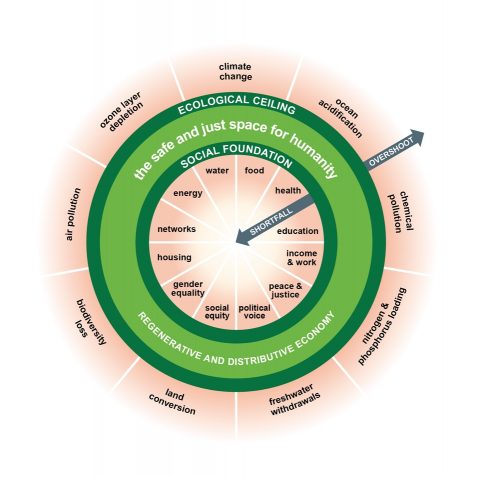“We need to take a holistic approach as we begin to reimagine and remake our own futures.”
“We have to care about climate, health, and jobs and housing and care and communities.”
.
 Back in 2017, an Oxford economist launched a new approach, with an interesting name:
Back in 2017, an Oxford economist launched a new approach, with an interesting name:
Futures Forum: Doughnut economics
.
The Doughnut, or Doughnut economics, is a visual framework for sustainable development – shaped like a doughnut or lifebelt – combining the concept of planetary boundaries with the complementary concept of social boundaries.[1]
The framework was proposed to regard the performance of an economy by the extent to which the needs of people are met without overshooting Earth’s ecological ceiling.[2]
en.wikipedia.org/wiki/Doughnut_(economic_model)
.
.
The model is now coming to Amsterdam:
.
.
Amsterdam Doughnut Economics | youtube.com
.
What is particularly interesting is that the city sees this model as crucial as a tool for regeneration after lockdown:
.
Introducing the Amsterdam City Doughnut
We never imagined that we would be launching it in a context of crisis such as this, but we believe that the need for such a transformative tool could hardly be greater right now, and its use in Amsterdam has the chance to inspire many more places – from neighbourhoods and villages to towns and cities to nations and regions – to take such a holistic approach as they begin to reimagine and remake their own futures.
kateraworth.com/2020/04/08/amsterdam-city-doughnut/
.
Amsterdam to embrace ‘doughnut’ model to mend post-coronavirus economy
Dutch officials and British economist to use guide to help city thrive in balance with planet
A doughnut cooked up in Oxford will guide Amsterdam out of the economic mess left by the coronavirus pandemic.
While straining to keep citizens safe in the Dutch capital, municipality officials and the British economist Kate Raworth from Oxford University’s Environmental Change Institute have also been plotting how the city will rebuild in a post-Covid-19 world.
The conclusion? Out with the global attachment to economic growth and laws of supply and demand, and in with the so-called doughnut model devised by Raworth as a guide to what it means for countries, cities and people to thrive in balance with the planet.
Raworth’s 2017 bestselling book, Doughnut Economics: Seven Ways to Think Like a 21st-Century Economist, has graced the bedside table of people ranging from the former Brexit secretary David Davis to the Guardian columnist George Monbiot, who described it as a “breakthrough alternative to growth economics”.
The inner ring of her donut sets out the minimum we need to lead a good life, derived from the UN’s sustainable development goals and agreed by world leaders of every political stripe. It ranges from food and clean water to a certain level of housing, sanitation, energy, education, healthcare, gender equality, income and political voice. Anyone not attaining such minimum standards is living in the doughnut’s hole.
The outer ring of the doughnut, where the sprinkles go, represents the ecological ceiling drawn up by earth-system scientists. It highlights the boundaries across which human kind should not go to avoid damaging the climate, soils, oceans, the ozone layer, freshwater and abundant biodiversity.
Between the two rings is the good stuff: the dough, where everyone’s needs and that of the planet are being met.
On Wednesday, the model will be formally embraced by the municipality of Amsterdam as the starting point for public policy decisions, the first city in the world to make such a commitment.
“I think it can help us overcome the effects of the crisis”, said Amsterdam’s deputy mayor, Marieke van Doorninck, who joined Raworth in an interview with the Guardian via Skype before the launch. “It might look strange that we are talking about the period after that but as a government we have to … It is to help us to not fall back on easy mechanisms.”
“When suddenly we have to care about climate, health, and jobs and housing and care and communities, is there a framework around that can help us with all of that?” Raworth says. “Yes there is, and it is ready to go.”
The central premise is simple: the goal of economic activity should be about meeting the core needs of all but within the means of the planet.
…
Amsterdam to embrace ‘doughnut’ model to mend post-coronavirus economy | theguardian.com
.
And since its launch earlier this month, it’s been capturing a lot of attention:
Amsterdam adopts first ‘city doughnut’ model for circular economy | smartcitiesworld.net
Amsterdam is the First City to Implement the Doughnut Economic Model | intelligentliving.co